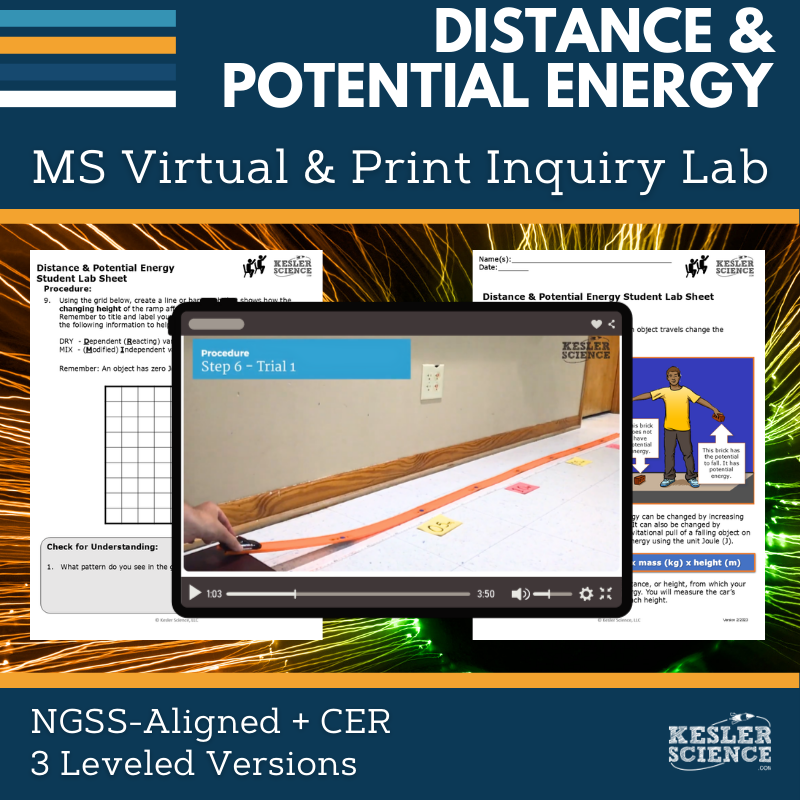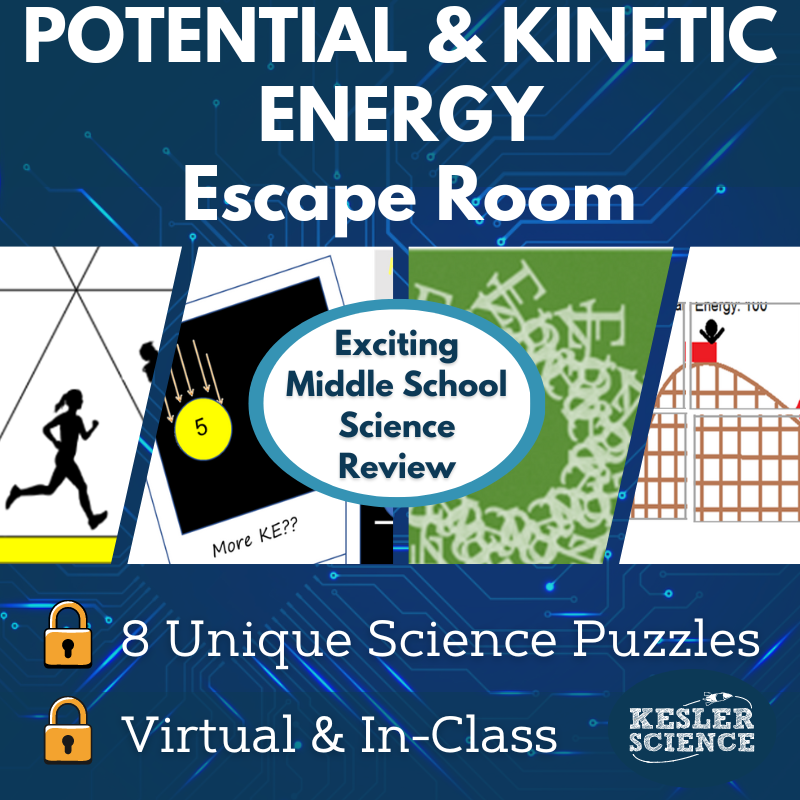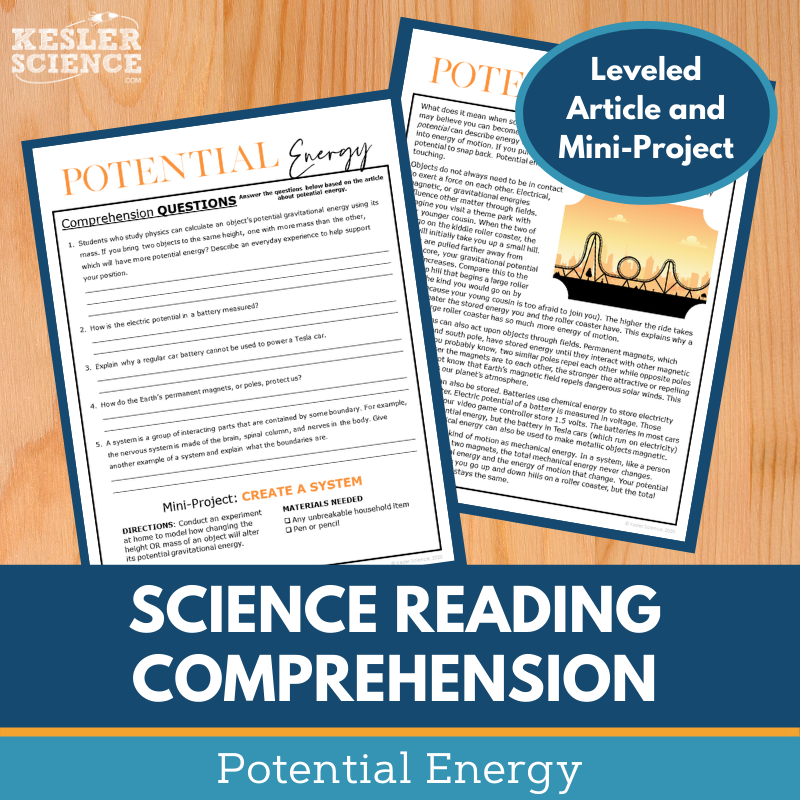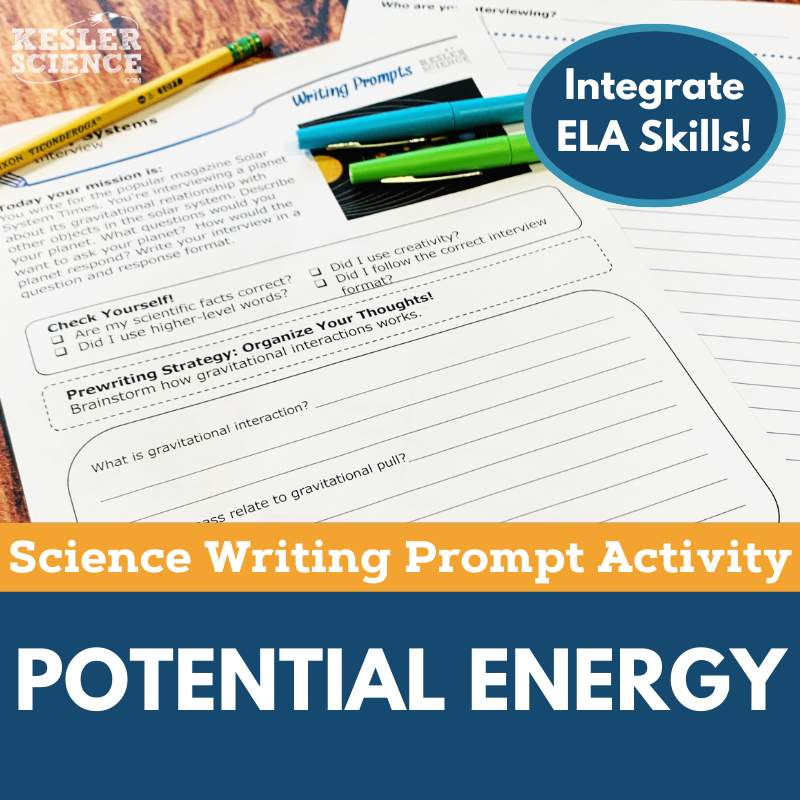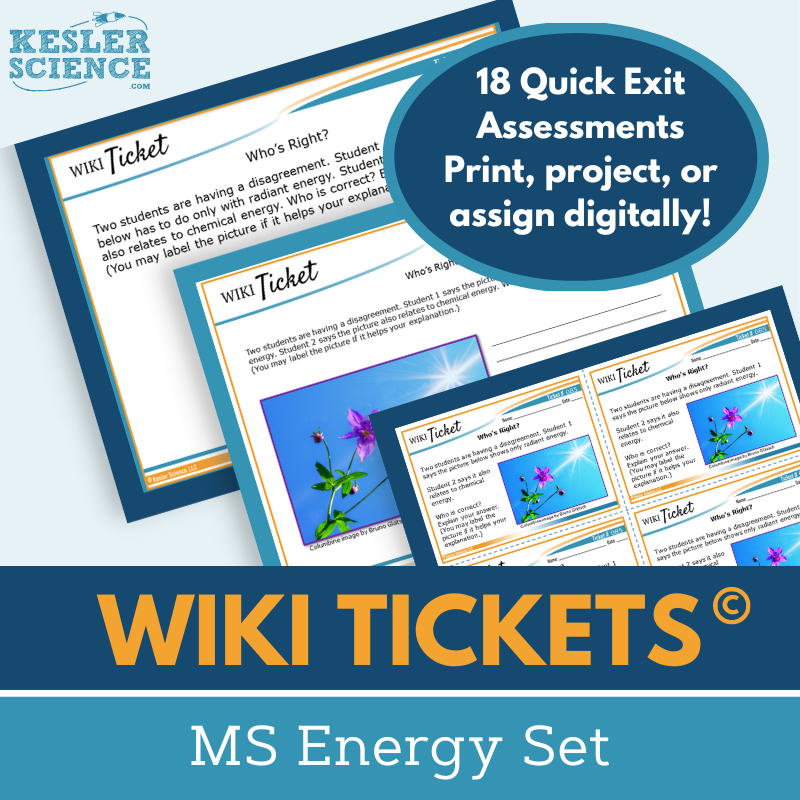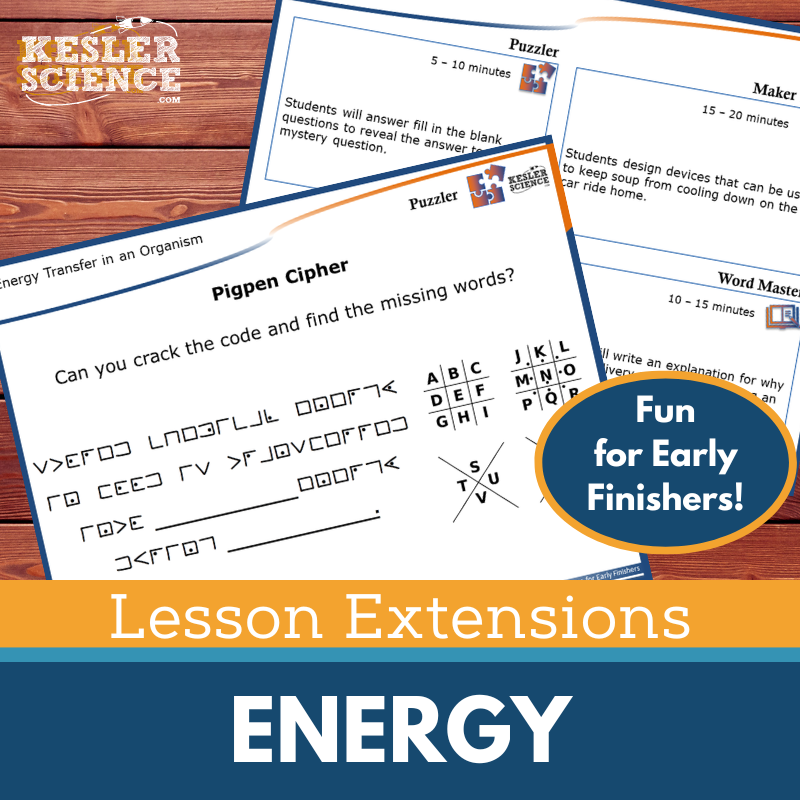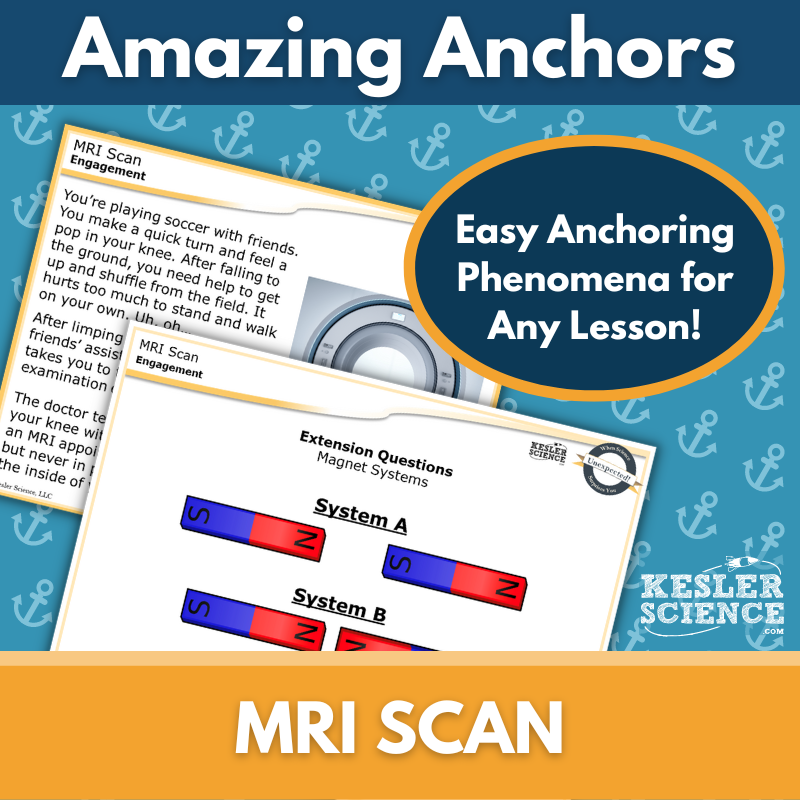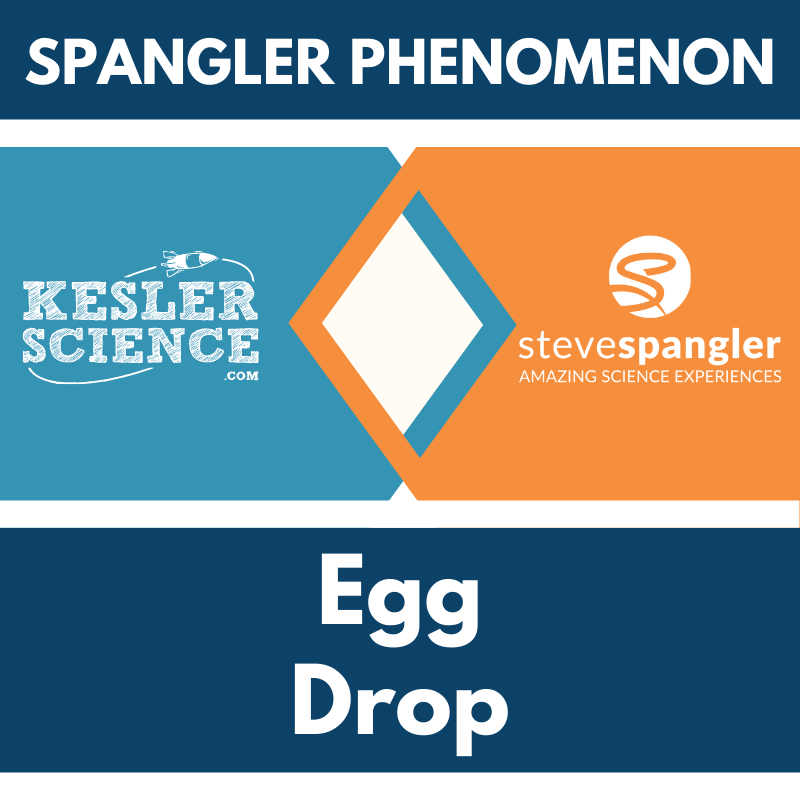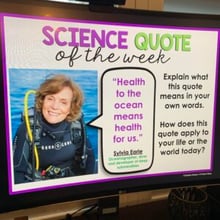Distance & Potential Energy Activities for Middle School Science
Aligned with NGSS MS-PS3-2, these engaging lessons help students explore the relationship between distance, height, and potential energy through hands-on experiments, interactive digital activities, reading comprehension, and creative writing exercises. These lessons integrate crosscutting concepts and science and engineering practices, providing a comprehensive and interactive approach to mastering potential energy. All of the following materials are also included in the Kesler Science Membership.
The Distance and Potential Energy Inquiry Lab aligns with NGSS MS-PS3-2, guiding students to develop a model that demonstrates how changing an object's height affects its potential energy. This flexible lab includes both a hands-on printed experiment and a virtual version with a pre-recorded video demonstration, making it accessible for all learning environments.
Students investigate how altering the height of a car's ramp influences its potential energy. The lab includes comprehension questions, Claim-Evidence-Reasoning (C.E.R.) prompts, and a reflection section. Differentiation is built in with three levels: Dependent (guided inquiry), Modified (structured with supports), and Independent (student-led exploration).
The print version provides a hands-on experience where students work in groups using toy cars, tracks, a scale, books or blocks for a ramp, and a stopwatch. The digital version is an interactive PowerPoint compatible with Google Slides, MS Teams, Schoology, and Canvas, requiring no materials. A recorded lab procedure allows students to follow along with a teacher-led demonstration.
Kesler Science ensures adaptability with editable PowerPoints, multimodal learning strategies, and teacher resource pages that include standards, objectives, prep time, and answer keys. Both print and digital formats contain all three differentiated levels, allowing maximum flexibility for classroom use.
The Distance and Potential Energy Inquiry Lab aligns with NGSS MS-PS3-2, guiding students to develop a model that demonstrates how changing an object's height affects its potential energy. This flexible lab includes both a hands-on printed experiment and a virtual version with a pre-recorded video demonstration, making it accessible for all learning environments.
Students investigate how altering the height of a car's ramp influences its potential energy. The lab includes comprehension questions, Claim-Evidence-Reasoning (C.E.R.) prompts, and a reflection section. Differentiation is built in with three levels: Dependent (guided inquiry), Modified (structured with supports), and Independent (student-led exploration).
The print version provides a hands-on experience where students work in groups using toy cars, tracks, a scale, books or blocks for a ramp, and a stopwatch. The digital version is an interactive PowerPoint compatible with Google Slides, MS Teams, Schoology, and Canvas, requiring no materials. A recorded lab procedure allows students to follow along with a teacher-led demonstration.
Kesler Science ensures adaptability with editable PowerPoints, multimodal learning strategies, and teacher resource pages that include standards, objectives, prep time, and answer keys. Both print and digital formats contain all three differentiated levels, allowing maximum flexibility for classroom use.
The Potential and Kinetic Energy Escape Room is an engaging, interactive activity that allows students to explore and apply their knowledge of kinetic and potential energy. Designed to align with NGSS standards MS-PS3-1, MS-PS3-2, and MS-PS3-5, this escape room challenges students to analyze energy transfer, construct models, and interpret data in a fun, immersive way.
Teachers have full control over the eight independent puzzles, allowing for customization based on class length and student needs. The escape room can be conducted using simple materials like manila envelopes or with a more elaborate setup involving locks and a storage box. Printable materials, answer keys, and detailed teacher directions are included to facilitate easy setup.
For digital learning, a Single Student Digital Version is available in PowerPoint, which can be assigned via email or a learning management system and uploaded to Google Slides. A print-friendly version in PPT and PDF formats is also provided for at-home use. The resource includes video challenges, editable teacher versions, a digital answer sheet via Google Forms, printable props, prize ideas, and themed signs for student photos. This dynamic escape room will leave students excited about science and eager to learn more.
The Potential and Kinetic Energy Escape Room is an engaging, interactive activity that allows students to explore and apply their knowledge of kinetic and potential energy. Designed to align with NGSS standards MS-PS3-1, MS-PS3-2, and MS-PS3-5, this escape room challenges students to analyze energy transfer, construct models, and interpret data in a fun, immersive way.
Teachers have full control over the eight independent puzzles, allowing for customization based on class length and student needs. The escape room can be conducted using simple materials like manila envelopes or with a more elaborate setup involving locks and a storage box. Printable materials, answer keys, and detailed teacher directions are included to facilitate easy setup.
For digital learning, a Single Student Digital Version is available in PowerPoint, which can be assigned via email or a learning management system and uploaded to Google Slides. A print-friendly version in PPT and PDF formats is also provided for at-home use. The resource includes video challenges, editable teacher versions, a digital answer sheet via Google Forms, printable props, prize ideas, and themed signs for student photos. This dynamic escape room will leave students excited about science and eager to learn more.
The Potential Energy Science Reading Comprehension Lesson helps students explore how changes in the arrangement of objects interacting at a distance affect stored potential energy. Designed for middle school, the leveled nonfiction passage enhances science literacy and reading comprehension.
Students read about potential energy, answer five to seven comprehension questions, and design an experiment modeling how changes in height or mass impact gravitational potential energy. The resource includes a hands-on mini-project, a Cornell notes template, and engaging graphics that print well in grayscale.
Suitable for grades 6-8 and advanced 5th graders, the passage has a Lexile range of 1100-1300 and is compatible with virtual learning platforms like Google Classroom, MS Teams, Schoology, and Canvas. Students can complete responses digitally or on paper. Perfect for sub plans, extra credit, ISS, or whole-class instruction, this resource fosters critical thinking, classroom discussions, and textual analysis.
The Potential Energy Science Reading Comprehension Lesson helps students explore how changes in the arrangement of objects interacting at a distance affect stored potential energy. Designed for middle school, the leveled nonfiction passage enhances science literacy and reading comprehension.
Students read about potential energy, answer five to seven comprehension questions, and design an experiment modeling how changes in height or mass impact gravitational potential energy. The resource includes a hands-on mini-project, a Cornell notes template, and engaging graphics that print well in grayscale.
Suitable for grades 6-8 and advanced 5th graders, the passage has a Lexile range of 1100-1300 and is compatible with virtual learning platforms like Google Classroom, MS Teams, Schoology, and Canvas. Students can complete responses digitally or on paper. Perfect for sub plans, extra credit, ISS, or whole-class instruction, this resource fosters critical thinking, classroom discussions, and textual analysis.
The Potential Energy Science Writing Prompt Activity engages middle school students in a creative “Day in the Life” writing exercise to reinforce their understanding of potential energy. Aligned with NGSS MS-PS3-2, this low-prep, student-centered activity encourages science reasoning and exploration while supporting both in-person and virtual learning.
This resource includes teacher directions with answer guides and rubrics, projection and print handouts, and a digital PowerPoint version compatible with Google Slides. Students receive full-sized and half-sheet handouts featuring the writing prompt, self-check tools, and pre-writing strategies. The activity works well as a cross-curricular exercise, pre-test assessment, student choice project, or enrichment for early finishers. It is also ideal for extra credit, make-up work, TELPAS samples, or differentiation.
Designed to engage students in reviewing prior knowledge, this writing prompt makes a great addition to interactive notebooks, writing journals, or classroom bulletin boards.
The Potential Energy Science Writing Prompt Activity engages middle school students in a creative “Day in the Life” writing exercise to reinforce their understanding of potential energy. Aligned with NGSS MS-PS3-2, this low-prep, student-centered activity encourages science reasoning and exploration while supporting both in-person and virtual learning.
This resource includes teacher directions with answer guides and rubrics, projection and print handouts, and a digital PowerPoint version compatible with Google Slides. Students receive full-sized and half-sheet handouts featuring the writing prompt, self-check tools, and pre-writing strategies. The activity works well as a cross-curricular exercise, pre-test assessment, student choice project, or enrichment for early finishers. It is also ideal for extra credit, make-up work, TELPAS samples, or differentiation.
Designed to engage students in reviewing prior knowledge, this writing prompt makes a great addition to interactive notebooks, writing journals, or classroom bulletin boards.
The WIKI Tickets© Energy Set provides engaging formative assessments for 6th-8th grade science, offering flexible ways to check student understanding. This set includes 18 topics, each available in five formats: a full-screen projection version, three printable handouts (full, split, and quarter-page sizes), and an interactive digital version compatible with PowerPoint and Google Slides.
Aligned to NGSS and TEKS standards, these assessments ensure comprehensive coverage, with at least one ticket per standard. A bonus table of contents file is included for alignment reference. Designed for both in-person and virtual learning, WIKI Tickets© can be used as exit tickets, bellringers, or quick checks. Topics covered include energy transformations, potential and kinetic energy, potential energy storage, heat transfer, wave characteristics, and more. Students can respond on printed handouts, their own paper, or digitally in a 1:1 or remote setting. These vibrant, ready-to-use assessments help you gauge student progress effectively in any learning environment.
The WIKI Tickets© Energy Set provides engaging formative assessments for 6th-8th grade science, offering flexible ways to check student understanding. This set includes 18 topics, each available in five formats: a full-screen projection version, three printable handouts (full, split, and quarter-page sizes), and an interactive digital version compatible with PowerPoint and Google Slides.
Aligned to NGSS and TEKS standards, these assessments ensure comprehensive coverage, with at least one ticket per standard. A bonus table of contents file is included for alignment reference. Designed for both in-person and virtual learning, WIKI Tickets© can be used as exit tickets, bellringers, or quick checks. Topics covered include energy transformations, potential and kinetic energy, potential energy storage, heat transfer, wave characteristics, and more. Students can respond on printed handouts, their own paper, or digitally in a 1:1 or remote setting. These vibrant, ready-to-use assessments help you gauge student progress effectively in any learning environment.
Lesson Extensions provide engaging, student-choice activities designed to challenge early finishers and deepen their understanding of energy concepts. These activities encourage critical thinking, creativity, and problem-solving while preventing distractions and making use of downtime. Aligned to NGSS and TEKS energy standards, they support independent learning and enrichment.
Each extension includes four interactive components: Puzzler for problem-solving, Maker Space for hands-on STEAM activities, Tech Connection for digital demonstrations, and Word Master for creative writing. With teacher directions, answer keys, and both print and projection versions, these extensions offer flexible, rigorous learning opportunities.
Covering topics such as energy transformations, kinetic and potential energy, thermal energy transfer, the electromagnetic spectrum, and photosynthesis, these extensions help students explore energy concepts in a meaningful way. Perfect for lesson wrap-ups, early finishers, or independent challenges, Lesson Extensions ensure continued engagement and deeper learning.
Lesson Extensions provide engaging, student-choice activities designed to challenge early finishers and deepen their understanding of energy concepts. These activities encourage critical thinking, creativity, and problem-solving while preventing distractions and making use of downtime. Aligned to NGSS and TEKS energy standards, they support independent learning and enrichment.
Each extension includes four interactive components: Puzzler for problem-solving, Maker Space for hands-on STEAM activities, Tech Connection for digital demonstrations, and Word Master for creative writing. With teacher directions, answer keys, and both print and projection versions, these extensions offer flexible, rigorous learning opportunities.
Covering topics such as energy transformations, kinetic and potential energy, thermal energy transfer, the electromagnetic spectrum, and photosynthesis, these extensions help students explore energy concepts in a meaningful way. Perfect for lesson wrap-ups, early finishers, or independent challenges, Lesson Extensions ensure continued engagement and deeper learning.
The NGSS-aligned Amazing Anchors lesson introduces magnets through an engaging real-world phenomenon: the MRI scanner. The two-part resource begins with an introductory reading on MRI technology, followed by comprehension and extension questions to prepare students for deeper learning. An explanatory reading then breaks down the science behind magnets in an accessible way, with additional reinforcement questions to extend understanding.
This no-prep lesson includes teacher directions with answer keys, projection slides, and both print and digital formats for flexible use. It offers full- and half-sheet handouts for interactive notebooks and editable materials to align with NGSS MS PS3-2. Designed to bookend a main lesson, these readings are ideal for the Engagement and Elaborate segments of the 5E model. A differentiated version provides sentence starters and modified language to support all learners. Perfect for in-person or virtual classrooms, this resource can be used on Google Classroom and other LMS platforms.
The NGSS-aligned Amazing Anchors lesson introduces magnets through an engaging real-world phenomenon: the MRI scanner. The two-part resource begins with an introductory reading on MRI technology, followed by comprehension and extension questions to prepare students for deeper learning. An explanatory reading then breaks down the science behind magnets in an accessible way, with additional reinforcement questions to extend understanding.
This no-prep lesson includes teacher directions with answer keys, projection slides, and both print and digital formats for flexible use. It offers full- and half-sheet handouts for interactive notebooks and editable materials to align with NGSS MS PS3-2. Designed to bookend a main lesson, these readings are ideal for the Engagement and Elaborate segments of the 5E model. A differentiated version provides sentence starters and modified language to support all learners. Perfect for in-person or virtual classrooms, this resource can be used on Google Classroom and other LMS platforms.
This Spangler Phenomenon lesson on potential energy features an exclusive Steve Spangler video for Kesler Science. The interactive investigation engages students with the question: How does changing the distance between two objects affect the potential energy stored in the system?
Designed within the 5E framework, this middle school NGSS physical science lesson incorporates the crosscutting concept of structure and function and the science and engineering practice of obtaining, evaluating, and communicating information.
Students begin by analyzing potential energy through an inspiring Steve Spangler video and a hands-on bouncy ball drop activity. They then explore key concepts in an engaging article, with opportunities to extend learning through additional activities like Station Labs and Inquiry Labs. Finally, they refine their understanding by revisiting the Steve Spangler explanation video and demonstrating their learning through writing, drawing, or building activities.
The lesson includes complete teacher directions, student handouts, two Steve Spangler videos, presentation slides in standard and interactive formats, and Vimeo links to eliminate concerns over ads. Available in PowerPoint and PDF, it can also be uploaded to Google Slides.
This Spangler Phenomenon lesson on potential energy features an exclusive Steve Spangler video for Kesler Science. The interactive investigation engages students with the question: How does changing the distance between two objects affect the potential energy stored in the system?
Designed within the 5E framework, this middle school NGSS physical science lesson incorporates the crosscutting concept of structure and function and the science and engineering practice of obtaining, evaluating, and communicating information.
Students begin by analyzing potential energy through an inspiring Steve Spangler video and a hands-on bouncy ball drop activity. They then explore key concepts in an engaging article, with opportunities to extend learning through additional activities like Station Labs and Inquiry Labs. Finally, they refine their understanding by revisiting the Steve Spangler explanation video and demonstrating their learning through writing, drawing, or building activities.
The lesson includes complete teacher directions, student handouts, two Steve Spangler videos, presentation slides in standard and interactive formats, and Vimeo links to eliminate concerns over ads. Available in PowerPoint and PDF, it can also be uploaded to Google Slides.
Year-Round Resources
These year-round activities will increase your students' understanding of many middle school science topics. All of these activities are also included in the Kesler Science Membership.
Visual Data & Graphing
You're not alone if your students struggle with understanding graphs, charts, and tables. It's a skill that takes an enormous amount of practice. This resource will help students build a strong foundation in analyzing data and creating their own data visualizations.
Bell Ringers and Warm-Ups
These middle school science bell ringers are an excellent way to engage your students as soon as they walk into your classroom. This comprehensive FULL YEAR resource includes everything you need to start off each science class with an interesting warm-up activity.
Review Board Games
Each game board has been carefully designed to keep students engaged. There are 10 different action spaces on each board and dozens of question cards. All of the actions are related to science concepts and keep the students motivated throughout the game.
Each game is ready to play. Simply print out the board and the cards and let the students enjoy reviewing nine different units.
Essential Questions and Standards
Below are the essential questions and standards associated with the lessons and activities included in the distance and potential energy unit. This topic is only one of more than 100 middle school science topics included in the Kesler Science Membership.
-
How can changing the distance (height) an object travels change the potential energy of an object?
-
NGSS - MS-PS3-2 Distance & Potential Energy
Kesler Science Membership
Imagine never having to search for another middle school science lesson again. The membership gives you access to ALL of the Kesler Science products in one place (Yes, including everything above).
Say goodbye to long hours of lesson prep.

